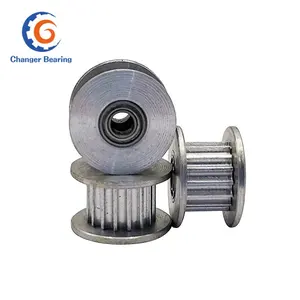

Idler Pulley Factory Direct Supply 3D Printer Idler Pulley GT2 Timing Belt Pulley 16T/20T 3*6mm 4*6mm 5*6mm

Custom Made Gray Cast Iron Belt Flywheel 200 Kg Agricultural Machinery Pullery Investment Casting Steel Parts















An idler pulley is an integral component in the machinery of vehicles, playing a pivotal role in the function of transmission systems. This category encompasses a variety of pulleys that contribute to the regulation of belt tension and the transmission of power within an engine. The idler pulley ensures the proper routing and tension of the drive belts, which is crucial for efficient vehicle operation.
The diversity of idler pulleys includes the flat belt pulley, v belt idler pulley, and serpentine belt idler pulley. Each type serves a specific function. Flat belt pulleys are commonly used in applications requiring high-speed and low-torque, whereas V-belt idler pulleys are designed to maintain the tension and alignment of V-belts in various machinery. The serpentine belt idler pulley, on the other hand, is an essential part of the serpentine belt system in modern vehicles, guiding and tensioning the belt as it connects various engine components.
Idler pulleys are utilized in numerous applications beyond automotive, including industrial machinery and consumer appliances. The drive belt idler pulley and accessory belt idler pulley are particularly significant in automotive applications, ensuring that the drive belt operates smoothly and with the correct tension. These pulleys are engineered for precision, as seen in products from precision pulley & idler, which are designed to meet exacting tolerances and ensure reliable performance.
The construction of an idler pulley can vary, with materials ranging from durable metals to reinforced plastics. The choice of material impacts the pulley's longevity and performance. For instance, a flat idler pulley made from hardened steel can resist wear and maintain performance under high tension. The advantages of using the correct idler pulley include reduced belt wear, improved power transmission, and decreased vibration and noise in the system.
Maintenance is key to ensuring the longevity of pulley systems. A bad idler pulley can manifest through squeaking noises, a misaligned belt, or visible wear on the pulley itself. It's essential to inspect these components regularly and replace them with compatible parts like the timing belt idler pulley or specific models such as 532194327 and 756 04224 to maintain the integrity of the system.
In summary, the idler pulley is a critical component in various mechanical systems, ensuring the proper function and longevity of belts. With a range of types and materials, these pulleys must be selected with precision to match the specific requirements of the application. Regular maintenance and timely replacement of components like the idler and tensioner pulley are essential for the smooth operation of any belt-driven system.